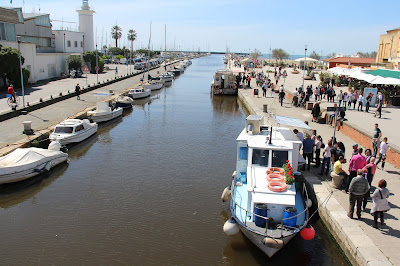Today we headed for our local Viareggio marina area, with nothing planned other than to enjoy the hot Saturday sun. Italians were out in droves. They really do know how to enjoy themselves, and they don't need much. We often see a family group sitting on a pavement corner enjoying a packed picnic on their day out. Just as well they don't need cut grass, as there isn't any. And parks are few and far between, and rarely found on the waterfront.
We parked where we could find space, which had us in a back lot beside the docks, tucked away in waterways that have been around as canal access since before the 1500s. Ancient. Here, Viareggians, became experts in building strong wooden boats that could carry the giant blocks of Carrara marble down the length of the coast of Italy dropping them off for clients like the Medicis, and artists like Michelangelo.
From the 19th century onwards, they became skilled at building fishing boats and thrived on that while the tide was high--further developing their ship carpentry, craftsmanship and engineering skills. Today, we saw small single operator boats roping themselves to the bollards along the canal before they headed to their final mooring. Here, they cleaned their fishing tackle and mended nets as they set out a fresh fish stall of their catch of the day to one side, and voila! a queue formed and their daily catch was gone. So fresh.
Other small boats operated as bobbing moored street food stalls selling crispy frittura mista di pesce to sun loving Italians out everywhere.
We ate in a fabulous canal side restaurant, Baracchina. Their fish soup has now taken up the Number 1 spot in my favourites for the region, filled as it was with crab and spice and all things seafood-nice.
These days Viareggio has taken on the luxury shipbuilding game in the Burlamacco canal and is now one of the world leaders in designing these giants in metal and fibreglass. We wandered passed massive modern boat building yards: Benetti, Perenni Navi, and Viscera Marine to name a few. Monster yachts under commissions from Russian oligarchs, Middle Eastern princes and technology billionaires were under construction. Business looks to be thriving.
An incredibly long black number, Seven, won an award for its lighting design. Such is the competition here that even lighting is a separate competitive category. Old buildings on shore alongside these shipbuilding docks, decorated in stainless steel and glass, hold window displays of chandlery, lighting, space-age technology and custom-design boat furniture. All looking very swish, even exotic.
Some yachts were under plastic wraps as they were getting their last coat of glossy paint and likely wanted no dust specks marring the work. Amazing luxury. Billions spent every year on these ships, just in Viareggio alone.
Today, throngs of Italians were out sunbathing on the large and lovely public beach we came across along the Lido. As we walked further along the jetty we came across a mournful statue, l'Attesa, depicting families waiting for their loved ones to return from the sea.
It was not far north of here, on remote rocks overlooking the sea at Lerici on the 8 July, 1822, that Mary Shelly, wife of the young poet Percy Bysshe Shelly, waited--somewhat like these stone statue figures--for her husband to return in his boat, the Don Juan, which he had not long modified to outpace Lord Byron's boat.
He did not arrive.
A vicious storm blew up and the seas raged and the modified top masts and sails caused his boat to struggle. He was offered help between Livorno and Viareggio by a boat captain who warned him he was in dire trouble in these conditions.
Shelly paid no heed.
Mary waited in vain. Percy's body was washed up days later on a Viareggio beach, unrecognisable, but for his clothing and a book of Keat's poems he had rapidly tucked into his coat pocket.
He was twenty-nine.
He was buried on the beach.
Barely a month later his body was dug out and burned there on a pyre with old friends, including Bryon, gathered around, waves lapping. His heart refused to burn, and was later given to Mary who wrapped it in silk and kept it close in her writing case until the end of her days.
Today, children make sandcastles in the sand on sunny days.
 |
| Daily catch for sale in shaded fresh fish stall |
 |
| Bobbing moored seafood stalls selling crispy frittura mista di pesce |
 |
| This Baracchina seafood soup is famous |
 |
| Massive boat building yards build monster yachts for Russian oligarchs and Middle Eastern princes |
 |
| Long black number, Seven, won an award for design |
 |
| Some still under plastic wraps protecting glossy paintwork |
 |
| Sunbathing on the Lido |
 |
| l'Attesa, depicting families waiting for loved ones to return from the sea |
 |
| Today children build sandcastles in the sand where Percy was buried |
No comments:
Post a Comment